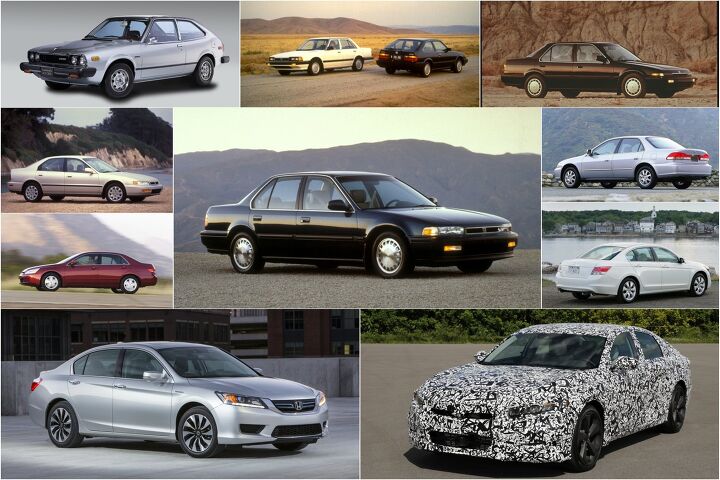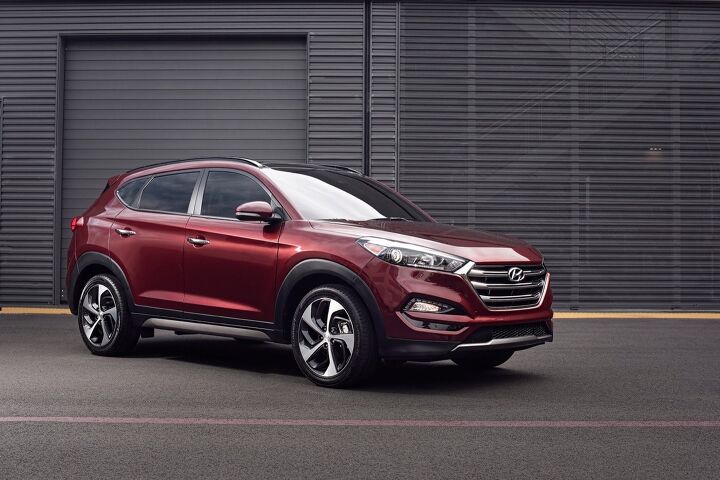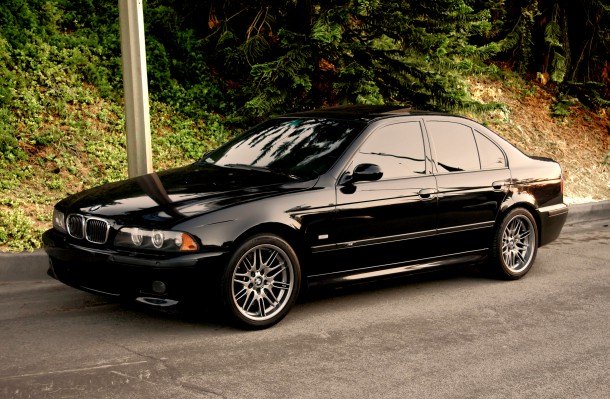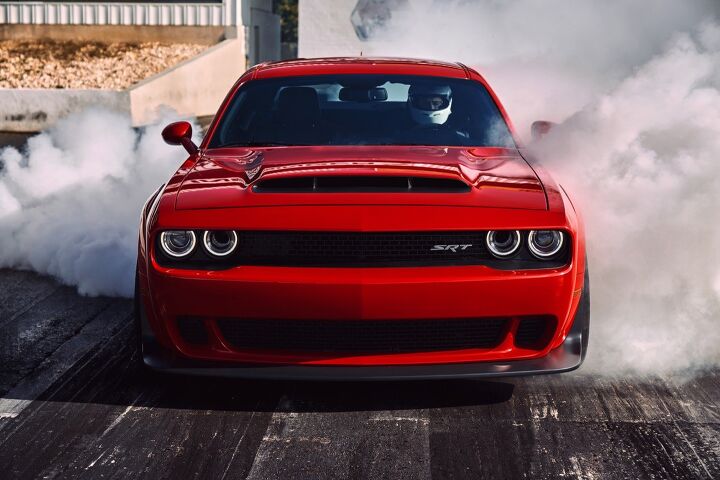#QOTDQuestionOfTheDay
QOTD: How Much Will You Pay for a New Car?
Last week, we told you that Americans are paying more for new cars than they’ve ever paid before while enjoying record-high incentives. Car buyers are able to spend more in large part because the payment terms are longer than ever before.
The average new vehicle purchase now requires a $32,900 expenditure, made possible by incentives of $3,550 per car and a loan term of 69.3 months. The average payment is now $517 per month.
But how much would you pay? What’s your maximum price, your maximum payment, your maximum term length?
QOTD: Which Honda Accord Is The Best Honda Accord?
Against its normal methodology, Honda is already leaking details regarding the all-new 2018 Accord, the tenth-generation of Honda’s venerable midsize car.
With continued manual transmission availability, a hi-po turbocharged 2.0-liter four-cylinder in place of a V6 upgrade that was part of the lineup for more than two decades, and another generation of coupes, the tenth-generation Honda Accord has the potential to be a terrific car.
But will it be the best Honda Accord?
American-built for 35 years, on the market for four decades, and the most popular car among TTAC’s devoted readership, the Honda Accord is a known entity. But not all Accords were created equal. Judge using whatever methodology you prefer: style, reliability, ride and handling, efficiency, interior quality. Then tell everyone which Honda Accord is the best Honda Accord.
QOTD: Do You Want a Tesla Model 3 or an Electric BMW 3 Series?
BMW intends to unveil an all-electric 3 Series at the Munich Auto Show in September, according to German business newspaper Handelsblatt.
Will BMW report the intake of hundreds of thousands of $1,000 deposits for an all-electric, next-generation BMW 3 Series? Probably not.
But which car are you more likely to purchase: a 3 Series EV from long-heralded BMW with roughly 250 miles of range, or the much-hyped, oft-discussed Model 3 from nascent Tesla, production of which should be in full swing by the time the 3 Series EV appears?
This may be the next Mustang vs. Camaro, a quasi Accord vs. Camry battle to end all Accord vs. Camry battles, an F-150 vs. Silverado skirmish without the 87 octane.
QOTD: Does Fiat Chrysler Automobiles Need More Cars?
The American new vehicle market is evolving. Indeed, the rate of evolution suggests it may be evolving fast enough to be deemed a revolution.
Passenger car market share is down to 37 percent through the first five months of 2017. We’re not even a decade removed from a time when passenger cars accounted for more than half of all U.S. auto sales. Cars have lost 4 percentage points of U.S. market share in just the last year. While pickup trucks, SUVs, and crossovers added 225,000 sales, year-over-year, in the first five months of 2017, passenger car volume tumbled by more than 145,000 units.
As a result, automakers are giving up on cars. Not wholeheartedly, not across the board, not routinely. But in specific areas. And this couldn’t be more obvious at Fiat Chrysler Automobiles, where the company no longer has entries in the two largest passenger car sectors. Heading into 2018, FCA’s car branch will market two Dodges, one Chrysler, and a handful of Fiats, Maseratis, and Alfa Romeos.
Is that enough? Or does Fiat Chrysler Automobiles need more cars?
QOTD: What Do We Call SUV Coupes If They're Not Coupes?
Vehicle classifications are important. They enable governments to better regulate. They allow uninformed buyers to get a grip on the market. They foster competition. They clarify conversation.
The passenger car sector is subdivided in countless ways, and not just by size. In the car realm, there are hatchbacks and liftbacks, convertibles and roadsters, station wagons and shooting brakes, sedans and coupes.
Yet when it comes to utility vehicles, besides differentiating (or attempting to differentiate, if there’s even any point) between SUVs and crossovers, much of the classification conversation revolves purely around size, from the subcompact Honda HR-V to the full-size Chevrolet Suburban.
So what’s this? I’m driving a Mercedes-AMG GLC43 4Matic Coupe this week. But we all know it’s not a coupe, which is traditionally known as a car with two doors and a fixed roof. Sometimes the coupe’s definition is even narrower. Yet never has the traditional coupe definition allowed for vehicles such as the GLC, BMW X4, BMW X6, or Mercedes-Benz’s GLE Coupe to be called coupes.
Still, we need to call them something.
QOTD: Are Hyundai's Troubles Nothing A Few SUVs Can't Fix?
This is not what you’d call a long history of sales difficulties for Hyundai, the seventh-best-selling auto brand in America. The 2016 calendar year was Hyundai Motor America’s best ever, the culmination of eight consecutive years of growth.
Yet while Hyundai rapidly — and not unpredictably — grew its U.S. sales coming out of the recession, nearly doubling its sales between 2008 and 2016, the rate of growth was notably slower in 2016 than in prior years. Blame capacity constraints, blame a car-centric lineup in an SUV-leaning world, blame conservative redesigns, blame whatever you want.
Regardless, Hyundai is feeling the pinch now. Year-over-year, sales have declined in each of the last six months. Hyundai’s U.S. CEO, Dave Zuchowski, was ousted just before Christmas 2016. In May 2017, for the first time ever, Kia outsold Hyundai in the United States. And on June 6, 2017, Hyundai Motor America’s vice president for sales, Derrick Hatami, exited the building as well.
All is not well. So then, more SUVs?
QOTD: How Does The Toyota C-HR Make You Feel?
People want to talk to me about the 2018 Toyota C-HR.
Since I took possession of a Toyota Canada-supplied C-HR last Friday, more people have approached me to discuss the C-HR than any other car I’ve ever had the pleasure or displeasure of testing.
Naturally, I assume they’re not going to have kind things to say. Let’s be honest: the Toyota C-HR is not a conventional beauty. “It’s not mine,” I quickly declare to a couple examining the C-HR in the grocery store parking lot as I approach it, bags in hand. “You can say whatever you think.”
And then they do. But the words they speak are not in keeping with my expectations.
QOTD: Is Subaru Now A Mainstream Automaker? And If So, Is That A Good Thing?
A band is only cool until everybody knows it’s cool.
Subaru, long a niche automaker with unique product offerings and limited geographic appeal, has tripled its U.S. market share over the last decade. Subaru will likely sell more than 650,000 new vehicles in the U.S. this year. The Subaru Outback and Forester are among America’s 12 most popular utility vehicles. And in a shrinking car market, U.S. sales of the Subaru Impreza — a newly launched compact for 2017 — are up 41 percent so far this year.
Subaru just dropped a new, fifth-gen Impreza 5-door in my driveway for a week-long test. It’s quite clearly the best Impreza ever: quiet, refined, solid, sufficiently powerful. The driver’s door armrest is plush. The car itself is — and we’re talking about an Impreza here — quite attractive.
The 2017 Subaru Impreza is, to be frank, normal. It doesn’t sound like a thrummy flat-four is present under the hood. The seating position doesn’t put your hips and feet on the same level. The windows have frames. There are other people driving the same car.
Has Subaru become a mainstream automaker? And if so, has some of Subaru’s appeal been lost?
QOTD: Do You Want a Ford Mustang or a Chevrolet Camaro?
It’s a question that goes back some 50 years.
Nixon or Humphrey.
No, wait. Camaro or Mustang.
Forget your Camry vs. Accord monotony, your F-150 vs. Silverado one-upmanship, and the Smart Fortwo vs. Scion iQ debate that routinely breaks the internet. This, this is the American automotive debate of the decade. And the decade before. And the decade before that.
It’s as though Ali and Frazier just kept on fighting. Annually. For decades. It’s the Yankees and Mets meeting in the World Series every year. It’s like — and I know you don’t want me to go there — Trump vs. Hillary in 2020, 2024, 2028, 2032, 2036…
If you could have just the one, which would it be? Ford Mustang or Chevrolet Camaro?
QOTD: What Car Do You Recommend Most Often?
Recommending vehicles, and having those recommendations go unheeded, is a key component of your role as an automotive enthusiast.
Whether you’re known as a go-to source for vehicle recommendations because of your encyclopedic automotive knowledge, because you’re a keen driver who once raced a Spec Miata, because you’ve brilliantly chosen five consecutive impeccably reliable midsize sedans, or because (like many TTAC contributors) you spend a week with new vehicles as they enter the market, you are relied upon by friends, family, and co-workers.
When asked, what new vehicle ends up topping your Most Recommended list? Forget Consumer Reports’ recommendations and Car And Driver’s 10 Best. If a friend asks you what new car they should buy, what car is it most likely to be?
QOTD: Do You Still Want A BMW?
The BMW M5, generation E39 from 1999-2003, continues to stand as one of my top five favorite cars of all time.
Yours too.
But the BMW of today is not the BMW that designed the 394-horsepower M5 nearly two decades ago. BMW now produces nearly half of its sales from utility vehicles and sells only a handful of sports cars each month. Setting aside classic sedan styling, the BMW of today will sell you ungainly X4s and X6s, plus bulbous hatchback versions of the 5 Series and 3 Series. Moreover, BMW’s core models — the 3 Series/4 Series — are distinctly less popular in the United States than they were a decade ago, when the market was smaller and the 3 Series lineup wasn’t as broad.
BMW is incentivizing its products heavily in early 2017 just to keep sales roughly where they were a year ago, a year in which BMW’s U.S. volume fell 9 percent compared with the 2015 peak.
Something’s not quite right. So do you, lover of the 1999 M5 and the BMW 2002 tii and the BMW 507 and the BMW Z8, still want a BMW?
QOTD: Can GM Be North America's Post-Volkswagen Diesel Answer?
We drove in and around the city in a 2017 GMC Canyon Duramax Diesel for 120 miles, then took a 180-mile journey to Prince Edward Island, and have since driven around that island 120 miles.
The result: 30.2 miles per gallon on the U.S. scale, a miserly 7.8 litres per 100 kilometres. It doesn’t hurt that, around these parts at the moment, diesel costs roughly $0.25 USD less per gallon versus regular.
The 2.8-liter four-cylinder under the hood of this GMC Canyon, with a paltry 181 horsepower but a stump-pulling 369 lb-ft of torque at just 2,000 rpm, is one of a handful of diesels General Motors has installed in U.S. market vehicles. The 6.6-liter Duramax V8 in heavy-duty pickup trucks is the one you hear rumble most often. But GM is also inserting the Cruze’s 240-lb-ft 1.6-liter turbodiesel into the third-gen Chevrolet Equinox and second-gen GMC Terrain.
With diesel engine offerings in two pickup truck lines, a compact car, and a pair of small SUVs, can General Motors — not Mazda, not Mercedes-Benz, not Skoda — be the North American diesel-lover’s answer now that Volkswagen committed its unclean diesel transgressions?
QOTD: Would the Pontiac Aztek Be Successful In 2017?
The Pontiac Aztek was widely regarded upon its 2000 debut as one of the ugliest new vehicles to ever set wheel on pavement. Between 2000 and the last sales trickle in 2007, General Motors sold just under 120,000 Azteks in the United States.
Americans were admittedly gung-ho for SUVs in the early part of this century, but not to the extent they are now. In 2002, for instance, when Aztek sales peaked, passenger cars still accounted for nearly half of all new vehicle sales. They account for just 37 percent now.
2017, not 2002, is the time for SUVs and crossovers. And while we’re not advocating for the return of the Pontiac Aztek, we wonder whether the Aztek would be far more successful now than it was then, and not just because everybody and their dog is now choosing an SUV/crossover instead of a car.
No, we wonder whether the Aztek would succeed in 2017 because, to be frank, there are already a wide variety of decidedly unattractive SUVs selling rather well today.
QOTD: Do You Still Care About Horsepower?
The 2018 Dodge Challenger SRT Demon produces 808 horsepower; 840 if you find some racing fuel.
I don’t care.
Don’t get me wrong. I like fast cars. I like fast SUVs. I like fast minivans. I like quick acceleration, high top speeds, rapid shifts, prodigious tire smoke, and burbly exhaust.
But outrageous horsepower numbers are almost becoming boring. They’re so common. So ordinary. So…
Easy.
Anybody can throw a few hundred extra horsepower at a decade-old muscle coupe. But what else can you do to impress me?
QOTD: Where Will Cadillac Be A Decade From Now?
Cadillac is in a curious state.
Many would rightly argue that Cadillac’s products are more competitive now than they’ve been in decades. Cadillac is making headway in China, a market which accounted for slightly more than half of Cadillac’s global volume in the first-quarter of 2017. Cadillac’s average U.S. transaction prices are also above the norm thanks in part to a high percentage of its sales being produced by the high-dollar Escalade.
But sales in Cadillac’s home market continue to slide. U.S. volume has fallen by a fifth over the last decade and has decreased in two of the last three years, falling to a four-year low in 2016. More recently, U.S. sales at Cadillac are down 5 percent in early 2017 after decreasing on a year-over-year basis in six of the last twelve months.
Long gone are the days when Cadillac could sell new vehicles in America at the same rate as Mercedes-Benz, BMW, or Lexus. Indeed, Cadillac is well back of Audi now, as well. To put an exclamation point on Cadillac’s difficulties, little ol’ Infiniti — also historically reliant on the U.S. market and rather weak globally — outsold Cadillac by a margin of more than 40 percent in March.
What’s next? Which brands will be outselling Cadillac in ten years, or even five, or even two?






























Recent Comments